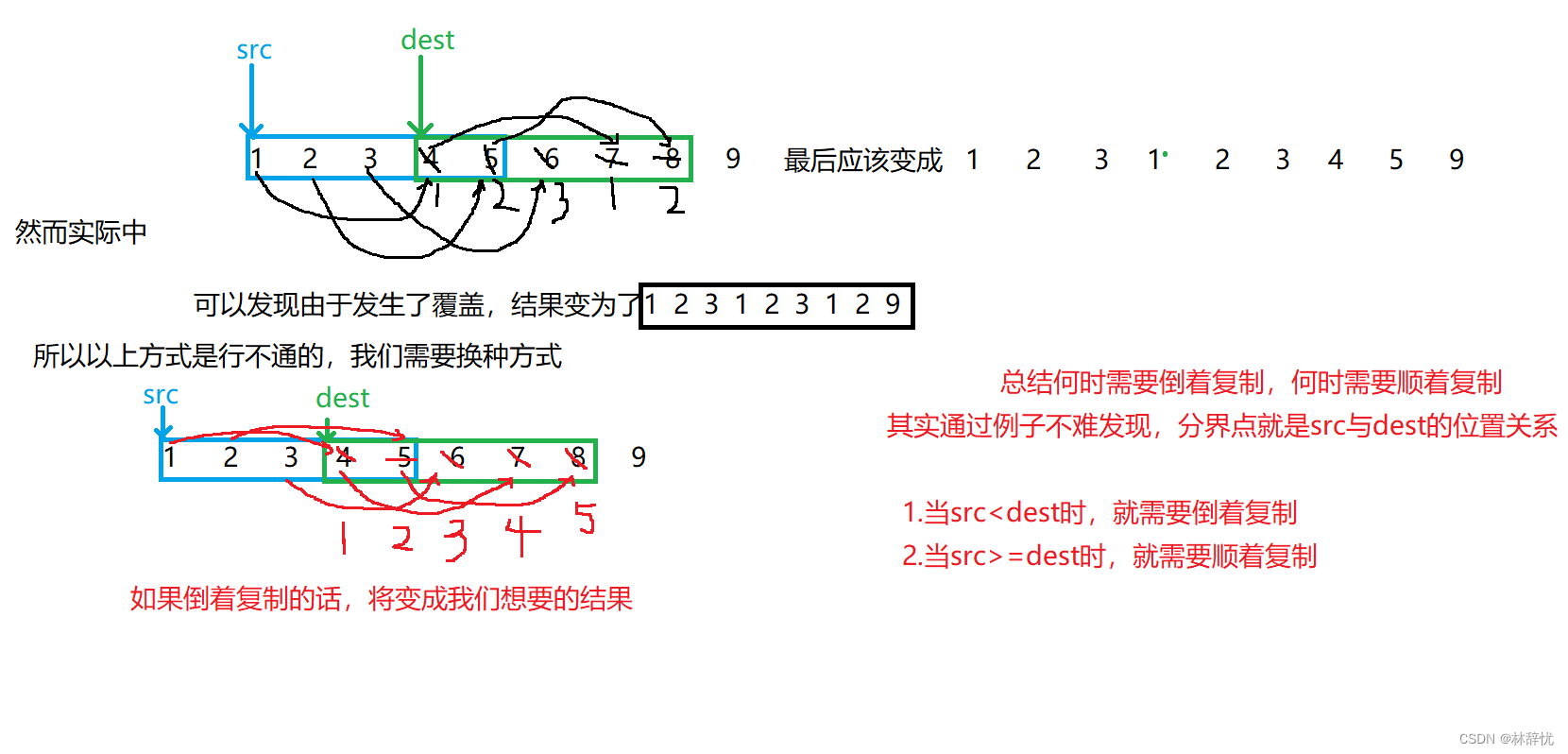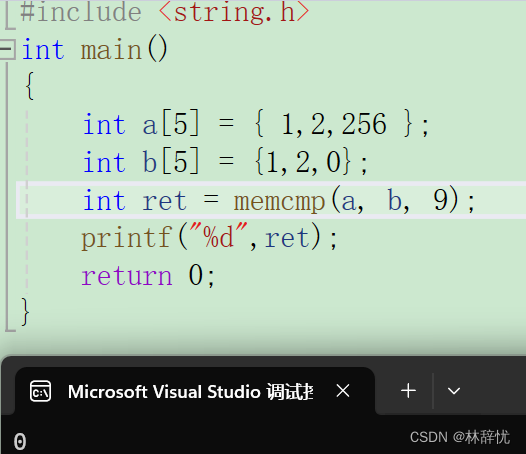新手必了解c语言之内存函数
发布时间:2024年01月16日
目录

听说看到日落金山的人,接下来的日子会顺顺利利,万事胜意,生活明朗-----------林辞忧
引言?
在了解各种各样的字符串函数之后,那么如果对于整型数组,浮点型数组或结构体数组该如何实现数组的复制,比较等操作呢,这就涉及到接下来的内存函数相关知识
一:内存拷贝函数(memcpy)(不含重叠)
1.函数介绍

?1.函数memcpy从source的位置开始向后复制num个字节的数据到destination的内存位置。
?2.这个函数在遇到 '\0' 的时候并不会停下来。
?3.如果source和destination有任何的重叠,复制的结果将会出错
?4.num的单位为字节
2.函数应用举例
#include <stdio.h>
#include <string.h>
int main()
{
int a[10] = { 1,2,3,4,5,6,7,8,9 };
int b[20] = { 0 };
memcpy(b, a,40 );
int i = 0;
for (; i < 10; i++)
{
printf("%d ",b[i]);
}
return 0;
}
3.函数模拟实现?
#include <stdio.h>
#include <string.h>
#include <assert.h>
//拷贝结束后返回目标空间的起始地址
void* my_memcpy(void* dest, const void* src, size_t num)
{
void* ret = dest;
assert(dest && src);
while (num--)
{
*(char*)dest = *(char*)src;
dest = (char*)dest+1;
src = (char*)src + 1;
}
return ret;
}
int main()
{
int a[10] = { 1,2,3,4,5,6,7,8,9 };
int b[20] = { 0 };
my_memcpy(b, a, 40);
int i = 0;
for (i = 0; i < 10; i++)
{
printf("%d ",b[i]);
}
return 0;
}二: 内存拷贝函数(memmove)(含重叠)
1.函数介绍

1.和memcpy的差别就是memmove函数处理的源内存块和目标内存块是可以重叠的。
2.如果源空间和目标空间出现重叠,就得使用memmove函数处理。
2.函数应用举例
int main()
{
int a[10] = { 1,2,3,4,5,6,7,8,9 };
// 如果要变成 1 2 1 2 3 4 5 8 9
memmove(a+2, a,20);
int i = 0;
for (i = 0; i < 10; i++)
{
printf("%d ",a[i]);
}
return 0;
}
3.函数模拟实现?
在正式的模拟实现之前,我们需了解下可能会出现的问题

#define _CRT_SECURE_NO_WARNINGS
#include <stdio.h>
#include <string.h>
void* my_memmove(void* dest, const void* src, size_t num)
{
void* ret = dest;
if (dest < src)//前->后
{
while (num--)
{
*(char*)dest = *(char*)src;
dest = *(char*)dest + 1;
src = *(char*)src + 1;
}
}
else//后->前
{
while (num--)
{
*((char*)dest + num) == *((char*)src + num);
}
}
return ret;
}
int main()
{
int a[] = { 1,2,3,4,5,6,7,8,9,10 };
//如果要求变成 1 2 1 2 3 4 5 8 9 10
my_memmove(a + 2, a, 20);
int i = 0;
for ( i = 0; i < 10; i++)
{
printf("%d ", a[i]);
}
return 0;
}三:内存比较函数(memcmp)?
1.函数介绍

这个函数和字符串比较函数strcmp的返回值这些基本一致,不同的是比较的是内存中的数据,num来限制比较的字节数,也就是一个一个的字节来比较的
2.函数应用举例?

四:谢谢观看?
?
文章来源:https://blog.csdn.net/Miwll/article/details/135625496
本文来自互联网用户投稿,该文观点仅代表作者本人,不代表本站立场。本站仅提供信息存储空间服务,不拥有所有权,不承担相关法律责任。 如若内容造成侵权/违法违规/事实不符,请联系我的编程经验分享网邮箱:chenni525@qq.com进行投诉反馈,一经查实,立即删除!
本文来自互联网用户投稿,该文观点仅代表作者本人,不代表本站立场。本站仅提供信息存储空间服务,不拥有所有权,不承担相关法律责任。 如若内容造成侵权/违法违规/事实不符,请联系我的编程经验分享网邮箱:chenni525@qq.com进行投诉反馈,一经查实,立即删除!
最新文章
- Python教程
- 深入理解 MySQL 中的 HAVING 关键字和聚合函数
- Qt之QChar编码(1)
- MyBatis入门基础篇
- 用Python脚本实现FFmpeg批量转换
- 2024.1.13每日一题
- OpenGL:关于纹理映射时任意四边形中的插值问题(二)
- MySQL基础
- 【JUC】三十二、邮戳锁StampedLock
- 造个轮子--用Python写个编程语言-函数与基本数据结构实现
- nodejs配置express服务器,运行自动打开浏览器
- Java中静态内部类
- mybatis TDSQL 避免事务失效 双层service
- 【教3妹学编程-算法题】找到最大周长的多边形
- MySQL DELETE 语句